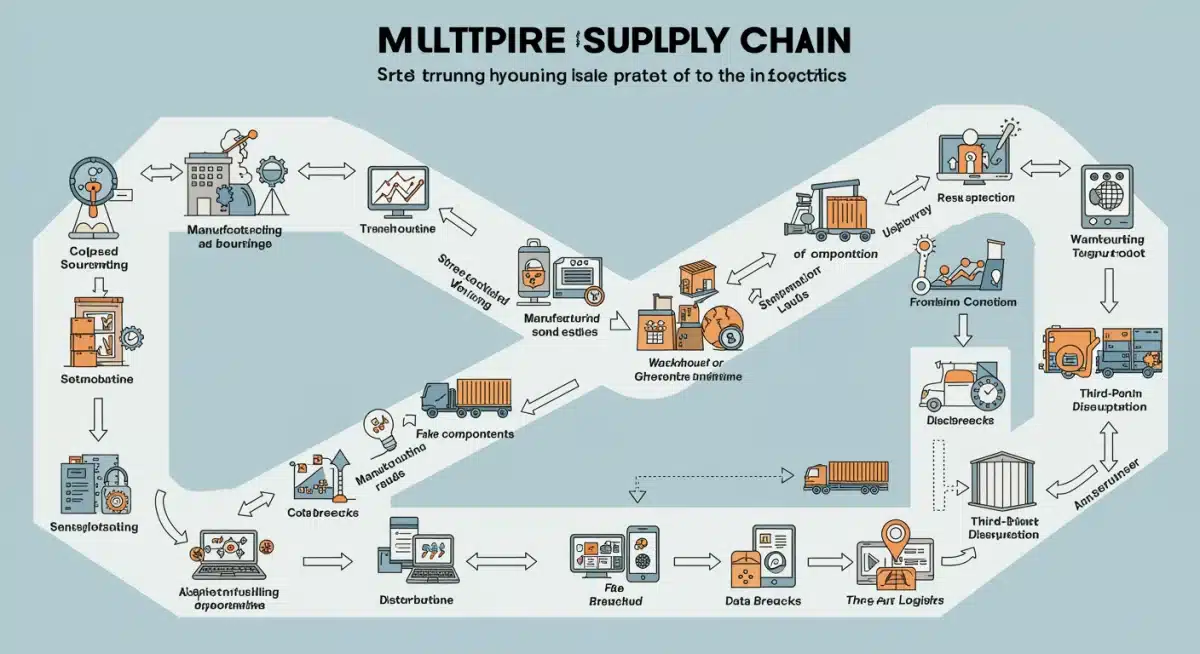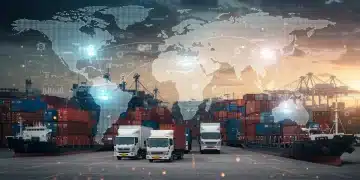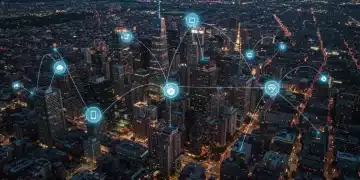Cybersecurity Threats to Global Supply Chains in 2025: A US National Security Brief (RECENT UPDATES)

As of late 2024, the landscape of cybersecurity threats to global supply chains in 2025: A US National Security Brief (RECENT UPDATES) continues to evolve rapidly, presenting unprecedented challenges. Are we adequately prepared for the sophisticated attacks targeting the intricate web of production and distribution? Recent intelligence suggests a significant uptick in state-sponsored activities and ransomware campaigns designed to disrupt critical infrastructure and economic stability.
Escalating Sophistication of Cyber Attacks
The nature of cyber threats targeting global supply chains is becoming increasingly sophisticated. Adversaries are no longer content with simple phishing scams; they are employing advanced persistent threats (APTs), zero-day exploits, and highly targeted social engineering techniques to infiltrate networks.
These attacks often aim for maximum disruption, not just data theft. The focus has shifted to operational technology (OT) and industrial control systems (ICS), which are the backbone of many manufacturing and logistics processes.
Advanced Persistent Threats (APTs)
APTs represent a significant danger due to their stealthy nature and long-term objectives. These groups, often backed by nation-states, can reside undetected within a network for months or even years, meticulously mapping out vulnerabilities and exfiltrating sensitive data.
- Stealthy infiltration and prolonged presence.
- Targeting of intellectual property and critical infrastructure blueprints.
- Ability to deploy destructive payloads at strategic moments.
Ransomware 2.0 and Extortion Tactics
Ransomware groups have also evolved, moving beyond mere encryption to include data exfiltration and double extortion. If victims refuse to pay, their stolen data is threatened for public release, adding immense pressure and reputational risk.
This new wave of ransomware often targets multiple points within a supply chain simultaneously, creating cascading failures across interconnected systems. The financial and operational impact can be devastating, forcing companies to halt production and service delivery.
Vulnerabilities in Third-Party Software and Services
A critical weak point in global supply chains is the reliance on third-party software and services. Many organizations integrate components from numerous vendors, each introducing potential vulnerabilities that can be exploited by malicious actors.
The SolarWinds attack in 2020 served as a stark reminder of how a single compromise in a widely used software product can ripple through countless organizations, including government agencies and critical infrastructure providers.
Software Supply Chain Risks
Software supply chain attacks involve tampering with software at any point before it reaches the end-user. This could include injecting malicious code into open-source libraries, compromising build environments, or even altering firmware during manufacturing.
- Dependency on open-source components with unknown vulnerabilities.
- Lack of rigorous security vetting for third-party software.
- Compromised software development pipelines.
Managed Service Provider (MSP) Exploitation
MSPs, which manage IT infrastructure for multiple clients, have become lucrative targets. A successful attack on an MSP can grant attackers access to all their clients’ networks, creating a force multiplier for cyber adversaries.
The interconnectedness of the digital ecosystem means that a vulnerability in one small service provider can have widespread consequences, affecting major corporations and even national security assets. This presents a significant challenge for risk management.
Geopolitical Tensions Fueling Cyber Warfare
Global geopolitical tensions are directly contributing to the heightened state of cyber warfare. Nation-states are increasingly using cyber capabilities as instruments of power projection, espionage, and sabotage, particularly against rivals or those they perceive as threats.
The US government has repeatedly highlighted concerns over state-sponsored attacks from countries like China, Russia, Iran, and North Korea, which often target critical infrastructure and defense industrial bases.
State-Sponsored Espionage
Espionage campaigns aim to steal sensitive information, including military secrets, intellectual property, and economic data. This intelligence can then be used to gain strategic advantages, undermine competitors, or develop advanced weapons systems.
These operations are often long-term and highly sophisticated, involving dedicated teams of cyber professionals. The goal is to maintain persistent access to target networks without detection, continuously gathering valuable information.

Destructive Cyber Attacks
Beyond espionage, some nation-states engage in destructive cyber attacks designed to disrupt essential services or cripple an adversary’s infrastructure. These can range from wiping data to disabling power grids or transportation networks.
- Targeting of energy grids and critical utilities.
- Disruption of financial markets and banking systems.
- Sabotage of defense manufacturing and logistics.
The Rise of AI and Quantum Computing in Cyber Threats
The rapid advancements in artificial intelligence (AI) and the nascent capabilities of quantum computing are set to revolutionize both cyber defense and offense. While AI offers powerful tools for threat detection, it also empowers attackers with new methods for automation and evasion.
Quantum computing, though still in its early stages, poses a long-term threat to current encryption standards, potentially rendering much of today’s secure communication vulnerable.
AI-Powered Attacks and Defenses
AI can be used by attackers to automate reconnaissance, generate highly believable phishing emails, and even develop novel malware. This accelerates the pace of attacks and makes them harder to detect using traditional methods.
Conversely, AI is also crucial for defense, enabling faster anomaly detection, predictive threat intelligence, and automated incident response. The race is on to leverage AI effectively on both sides of the cyber conflict.
Quantum Computing and Cryptographic Risks
Quantum computers have the theoretical ability to break current public-key cryptography algorithms, which are fundamental to securing online communications and data. While practical quantum computers are not yet widespread, the threat is real and requires proactive preparation.
Governments and industries are already investing in post-quantum cryptography research to develop new encryption standards that can withstand quantum attacks. This transition is a massive undertaking for global supply chains.
Regulatory and Policy Responses in the US
In response to these escalating threats, the US government has intensified its focus on cybersecurity for global supply chains. Recent policy updates emphasize collaboration between government and private sector entities, information sharing, and the implementation of robust security standards.
Executive orders and legislative initiatives aim to bolster the resilience of critical infrastructure and enhance the nation’s overall cyber posture.
Key Policy Directives
The Biden administration has issued several executive orders aimed at improving cybersecurity, particularly for federal agencies and their contractors. These directives often trickle down to influence private sector best practices.
- Mandatory reporting of cyber incidents for critical infrastructure.
- Enhanced software supply chain security standards.
- Increased information sharing between government and industry.
Public-Private Partnerships
Recognizing that the government cannot tackle these challenges alone, there’s a strong emphasis on public-private partnerships. Initiatives like CISA’s Joint Cyber Defense Collaborative (JCDC) aim to unify cyber defense efforts across sectors.
These collaborations facilitate threat intelligence sharing, coordinated incident response, and the development of collective defense strategies against common adversaries. They are vital for building a resilient national cybersecurity ecosystem.
Building Supply Chain Resilience and Transparency
Beyond immediate threat mitigation, the long-term goal is to build inherent resilience and transparency into global supply chains. This involves moving away from single points of failure, diversifying suppliers, and implementing end-to-end visibility solutions.
Organizations are increasingly adopting frameworks like the NIST Cybersecurity Framework to assess and manage their supply chain risks proactively.
Diversification and Redundancy
Reducing reliance on a single supplier or geographic region can mitigate the impact of a localized cyber attack or disruption. Building redundancy into critical components ensures continuity of operations even if one part of the chain is compromised.
This strategic shift requires significant investment and planning but is essential for long-term stability and security. It helps to distribute risk rather than concentrating it.
Enhanced Visibility and Traceability
Knowing exactly where components come from and their journey through the supply chain is crucial. Technologies like blockchain are being explored to provide immutable records of provenance, making it harder for malicious actors to introduce counterfeit or compromised parts.
Improved visibility allows organizations to quickly identify and isolate compromised elements, preventing widespread contamination. This proactive approach is fundamental to maintaining trust and integrity within global commerce.
| Key Threat | Brief Description |
|---|---|
| Advanced Persistent Threats | Nation-state backed groups conducting stealthy, long-term infiltrations for espionage and sabotage. |
| Software Supply Chain Attacks | Malicious code injection into software components or development processes, impacting numerous users. |
| Geopolitical Cyber Warfare | Nation-states using cyber capabilities for power projection, espionage, and destructive attacks against rivals. |
| AI-Enhanced Attacks | Attackers leveraging AI to automate, accelerate, and make cyber attacks more sophisticated and evasive. |
Frequently Asked Questions About Cybersecurity Threats
The primary threats include sophisticated Advanced Persistent Threats (APTs), evolving ransomware tactics, vulnerabilities in third-party software, and state-sponsored cyber warfare. These attacks aim to disrupt critical operations and steal sensitive data, impacting national security and economic stability.
Geopolitical tensions directly fuel cyber warfare, as nation-states use cyber capabilities for espionage, sabotage, and power projection. This leads to increased targeting of critical infrastructure, intellectual property, and defense industrial bases, escalating risks across global supply chains.
The US government is implementing executive orders and legislative initiatives to improve cybersecurity, emphasizing public-private partnerships, mandatory incident reporting, and enhanced software supply chain security standards. These efforts aim to bolster resilience and foster intelligence sharing.
Building resilience involves diversifying suppliers, implementing redundancy, and enhancing end-to-end visibility and traceability. Adopting robust cybersecurity frameworks like NIST and exploring technologies such as blockchain for provenance can help mitigate risks and prevent widespread disruptions.
What Happens Next
The dynamic nature of cybersecurity threats to global supply chains in 2025 means that vigilance and adaptation are paramount. We can expect continued efforts from adversaries to exploit new technologies like AI and quantum computing, pushing the boundaries of cyber defense. Organizations and governments must stay ahead through continuous intelligence gathering, robust investment in security technologies, and fostering deeper international cooperation. The coming months will likely see further regulatory developments and an intensified focus on securing every link in the supply chain, as the economic and national security stakes continue to rise.





